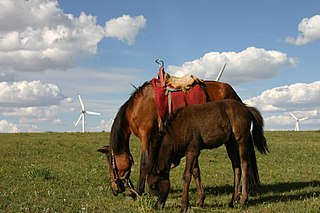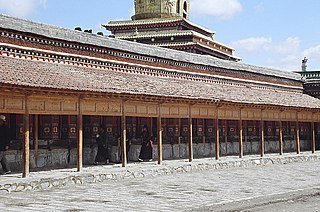
Xiahe County is a county in Gannan Tibetan Autonomous Prefecture, Gansu province, China, bordering Qinghai province to the west. The name, which literally means "Xia River", refers to the Daxia River which runs through the county. It is home to the famed Labrang Tibetan Buddhist monastery, one of the largest Tibetan Buddhist monasteries outside the Tibet Autonomous Region. The town is populated largely by ethnic Tibetans, as well as some Hui and Han Chinese. The area is highly rural and pastoral. The geography is mountainous. In recent years it has become a tourist attraction. The county was named Xiahe in 1928, after the Daxia River that flows through its territory.

A cashmere goat is a type of goat that produces cashmere wool, the goat's fine, soft, downy, winter undercoat, in commercial quality and quantity. This undercoat grows as the day length shortens and is associated with an outer coat of coarse hair, which is present all the year and is called guard hair. Most common goat breeds, including dairy goats, grow this two-coated fleece.

The Qijia culture was an early Bronze Age culture distributed around the upper Yellow River region of Gansu and eastern Qinghai, China. It is regarded as one of the earliest bronze cultures in China.

The Daxia River or Sangchu is a tributary of the Yellow River in southern Gansu Province in China's west.

The Himalayan wolf is a canine of debated taxonomy. It is distinguished by its genetic markers, with mitochondrial DNA indicating that it is genetically basal to the Holarctic grey wolf, genetically the same wolf as the Tibetan and Mongolian wolf, and has an association with the African wolf. No striking morphological differences are seen between the wolves from the Himalayas and those from Tibet. The Himalayan wolf lineage can be found living in Ladakh in the Himalayas, the Tibetan Plateau, and the mountains of Central Asia predominantly above 4,000 m (13,000 ft) in elevation because it has adapted to a low-oxygen environment, compared with other wolves that are found only at lower elevations.

Maqu County is a county of the Gannan Tibetan Autonomous Prefecture in the south of Gansu province of China, bordering the provinces of Sichuan to the east and southeast, and Qinghai to the southwest, west and northwest. Its postal code is 747300, and in 1999 its population was 36,213 people. The word "Maqu" derived from the Tibetan name of Yellow River. The area of Maqu County is 10,191 km2 with an average altitude of 3,700 meters. Maqu County receives high rainfall and is located at the northern edge of the Zoigê Marshes on the Yellow River where conditions are optimal for alpine meadow vegetation.
The Baise horse is a pony-sized horse breed native to the autonomous region of Guangxi, in southeastern China. Like other Asian breeds, it thrives at high altitudes and roams freely when not working. Guangxi's mild climate has long favored horse breeding; bronze statues from the third to the first centuries BCE exist of horses very similar in conformation to the Baise.

Neolithic Tibet refers to a prehistoric period in which Neolithic technology was present in Tibet.
Langmusi Town is a small alpine town on the eastern edge of the Tibetan Plateau, nestled in a valley shared between Gansu and Sichuan provinces in China and straddled by two large monastery complexes. Administratively, the town is part of Luqu County in Gannan Tibetan Autonomous Prefecture in Gansu, although a small portion of the town in the south is actually located in Zoigê County, Ngawa Tibetan and Qiang Autonomous Prefecture, Sichuan. The town is commonly visited by tourists making the overland trip between Sichuan and Gansu. Inhabitants of the town are primarily Tibetan.
Zhang Dongju is a Chinese archeologist and an associate professor at the College of Earth and Environmental Sciences of Lanzhou University. Zhang's research determined that the Xiahe mandible found in the Baishiya Karst Cave on the Tibetan Plateau shared DNA with fossilized remains found in the Denisova Cave in Siberia. This moved to 120,000 years earlier the dates of earliest proven hominin activities in the Tibetan Plateau, and revealed for the first time that the Denisovan hominins had spread throughout Asia rather than being located only near the Denisova Cave. Zhang's work is considered likely to prompt reconsideration of other fossil remains using ancient protein analysis. Discover, Science News, and Nova all named the discovery to their lists of top science stories of 2019.

Baishiya Karst Cave is a high-altitude paleoanthropological site and a Tibetan Buddhist sanctuary located on the northeastern edge of the Tibetan Plateau in Xiahe County, Gansu, China. This karst cave is the site of the discovery of the earliest hominin fossil found on the Tibetan Plateau, the Xiahe mandible. The mandible, by way of palaeoproteomic analysis, is the first confirmed discovery of a Denisovan fossil outside of Denisova Cave. This fossil discovery shows that archaic hominins were present in a high-altitude, low-oxygen environment by around 160,000 years ago.

The Xiahe mandible is a hominin fossil jaw (mandible) discovered in Baishiya Karst Cave, located on the northeastern edge of the Tibetan Plateau in Xiahe County, Gansu, China. By the use of palaeoproteomic analysis, it is the first confirmed discovery of a Denisovan fossil outside of Denisova Cave, and the most complete confirmed Denisovan fossil. This fossil discovery shows that archaic hominins were present in a high-altitude, low-oxygen environment around 160,000 years ago. Discover, Science News and Nova all named the discovery of the mandible in their lists of Top Science Stories of 2019.

Yushu is a horse breed originating from the Tibetan autonomous prefecture of Yushu in Tibet, administratively located in Qinghai, China. It is a local variety of the Tibetan pony. About its measurements, it is medium-sized and one of the few horse breeds that have the champagne gene. Its breeding was discouraged by Chinese authorities in the 1990s. Fit for the saddle, Yushu is adapted to its highland environment. It has been the subject of several studies on its genetic diversity and blood composition. The breed has become rare today, although it is not considered endangered by the Food and Agriculture Organization (FAO). It is honored every year at a major equestrian festival, which attracts thousands of spectators.
The Datonghorse is a breed of pony native to northern Qinghai province, China. It is best known for its relationship with the famous dragon horse in Zhou Muwang's biography, who held it in very high esteem. The Datong is a sturdy pony, perfectly adapted to life at altitude. Like many other Chinese horse breeds, its population is in decline.

In China, horses are present both physically and in art and beliefs, particularly those relating to astrology. In 1985, China had the world's largest herd of horses, numbering 11 million. China was at the origin of post houses in Eurasia. Since the 2000s sport and leisure riding have been developing in China, mainly for wealthy people.

The Chinese Mongolian is a breed of horse, corresponding to the population of Mongolian horses that remained in China after Mongolia's independence in 1910. Possibly descended from Przewalski's horse, it has been domesticated since ancient times. In 1982, they accounted for a third of all horses in China. Since then, their numbers have declined sharply, under the influence of mechanized transport and modern lifestyles.
The Abaga is a type of Chinese Mongolian horse. Characterized by its generally black coat, it is also larger and faster than the latter, due to its selection for racing.
The Chaidamu is a breed of horse native to Qinghai, Tibet and China. Closely related to the Mongolian horse, this working pony is mainly used for pulling. It has been in serious decline since the end of the 20th century, mainly due to the desertification of the Qaidam Basin.
The Shandan is a versatile horse breed originating from the unique Shandan stud farm, located in China's Qilian Mountains. This military stud has an ancient breeding tradition dating back to antiquity. The breed was created in the 1930s from numerous crosses between Chinese horses and the Russian Don horse. Long bred for military saddling and traction, it is now used for tourism.













